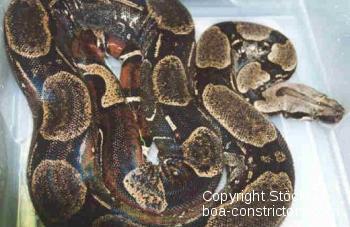Boa constrictor melanogaster
Distribution area Ecuador
Size of the black bellied boas identic to Boa c. constrictor
Particularity black belly
| Melanogaster Report |
Boa constrictor melanogaster information | black bellied boas information | size of Boa c. melanogaster | Boa c. melanogaster breeders | Boa c. melanogaster offspring | Black bellied Boas for sale | information on black bellied boas | true Boa c. melanogaster
Boa c. melanogaster
The red-tailed boas inhabiting the eastern Amazonian Basin of Ecuador look like snakes of the same (sub-)species living in Peru.
On the eastern slopes of the Andes, however, we find Boa c. constrictor which absolutely do not match this statement. We are talking about the so-called ‘black-bellied boas’, a variety described by LANGHAMMER in 1983. This author’s proposal to classify these animals as a new subspecies (Boa c. melanogaster) failed to be recognized. Most standard works refer to these snakes as a color morph of Boa c. constrictor – a point of view which is absolutely justified in our opinion.
The ‘black-bellied boas‘ are very dark Boa constrictors whose saddle patches laterally fuse into each other.
In the individuals photographed so far, the ‘bat pattern’ typical of most Boa c. constrictor is developed rather vaguely. Their dorsal patches are characterized by numerous dark dots intensely spotted over a somewhat paler background. The tail does not show the cherry red one observes in other Boa c. constrictor but is instead a darker mahogany red.
The reason for LANGHAMMER’S classification of these Boa constrictors as a subspecies of its own is mainly based upon their belly coloration. As the common name already indicates, the bellies of adult individuals are almost plain black instead of showing the pale ground speckled in black we know from other Boa c. constrictor. However, we have also encountered very dark specimens from Suriname and Guyana which might have been classified as ‘Boa c. melanogaster’ with a little goodwill if this criterion was considered. In young black-bellied boas, the ventral surface is still only dotted in black. The overall black coloration begins to develop only in older individuals, starting from the tail end.

